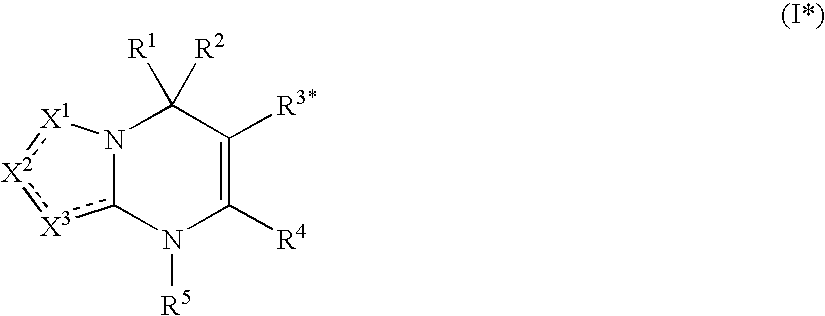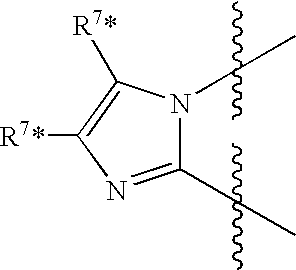Heterocyclic dihydropyrimidine compounds
a technology of heterocyclic dihydropyrimidine and compound, which is applied in the field of heterocyclic dihydropyrimidine compounds, can solve the problems of selective, affecting the research progress of the field, and affecting the development of the field,
- Summary
- Abstract
- Description
- Claims
- Application Information
AI Technical Summary
Benefits of technology
Problems solved by technology
Method used
Image
Examples
example 1
7-(2,3-Dichlorophenyl)-4,7-dihydro-5-methylpyrazolo[1,5-a]pyrimidine-6-carboxylic acid methyl ester
[0179]
Method:
[0180][0181]Step A: A mixture of methyl acetoacetate 1 (5 mL, 46 mmol), 2,3-dichlorobenzaldehyde 2 (8.1 g, 46 mmol), piperidine (1.1 ml, 12 mmol), and acetic acid (0.6 mL, 11 mmol) in toluene (200 mL) was refluxed overnight with azeotropic removal of water via a Dean-Stark trap. The mixture was cooled to room temperature, quenched with water, transferred to a separatory funnel, diluted with ethyl acetate, washed with aqueous NaOH (1M), aqueous HCl (1M), water and brine and concentrated in vacuo. The residue was purified by flash chromatography (silica gel, 33% Ethyl acetate / hexanes) to afford 10.8 g (85% yield) of compound 3 as a mixture of diasteromers. Reverse Phase LC / MS: YMC S5 ODS 4.6×50 mm Ballistic column, UV detection at 220λ, 4 min. gradient (10% MeOH / H2O with 0.1% TFA-90% MeOH / H2O with 0.1% TFA), 4 mL / min. Diastereomer A, Rt=3.51 min,(53%) Diastereomer B, Rt=3.70...
examples 2 and 3
[0183]The compounds of Examples 2 and 3, shown in the table provided below, were prepared in a manner similar to that described in Example 1.
[0184]
ExampleStructureName(M + H)27-(3,4-Dichlorophenyl)-4,7-dihydro-5-methylpyrazolo[1,5-a]pyrimidine-6-carboxylic acidmethyl ester33837-(4-Chlorophenyl)-4,7-dihydro-5-methylpyrazolo[1,5-a]pyrimidine-6-carboxylic acidmethyl ester303
example 4
7-(3,4-Dichlorophenyl)-4,7-dihydro-5-methylpyrazolo[1,5-a]pyrimidine-6-carboxylic acid 1,1-dimethylethyl ester
[0185]
Method 1:
[0186]
[0187]Compound 1: Compound 1 was prepared by condensing t-butoxyacetoacetate and 2,4-dichlorobenzaldehyde as described in Example 1 step A.
[0188]Title Compound: A mixture of compound 1 (44.4 g, 141 mmol), 3-aminopyrazole 2 (17.6 g 212 mmol) and sodium acetate (46.3 g, 564 mmol) in dimethylformamide (300 mL) was stirred at 70° C. overnight (17 h). The mixture was cooled to room temperature, transferred to a separatory funnel, diluted with water and ethyl acetate, washed with water (a small amount of methanol was added to breakup emulsions that formed) and brine, dried over anhydrous sodium sulfate and concentrated. A precipitate formed. The precipitate was collected and washed with ethyl acetate, ethyl ether and hexanes and dried to give 8.93 g. The mother liquor was concentrated to give a second crop of precipitate 9.32 g. LC / MS analysis indicated the pr...
PUM
| Property | Measurement | Unit |
|---|---|---|
| Volume | aaaaa | aaaaa |
| Fraction | aaaaa | aaaaa |
| Fraction | aaaaa | aaaaa |
Abstract
Description
Claims
Application Information
 Login to View More
Login to View More - R&D
- Intellectual Property
- Life Sciences
- Materials
- Tech Scout
- Unparalleled Data Quality
- Higher Quality Content
- 60% Fewer Hallucinations
Browse by: Latest US Patents, China's latest patents, Technical Efficacy Thesaurus, Application Domain, Technology Topic, Popular Technical Reports.
© 2025 PatSnap. All rights reserved.Legal|Privacy policy|Modern Slavery Act Transparency Statement|Sitemap|About US| Contact US: help@patsnap.com



